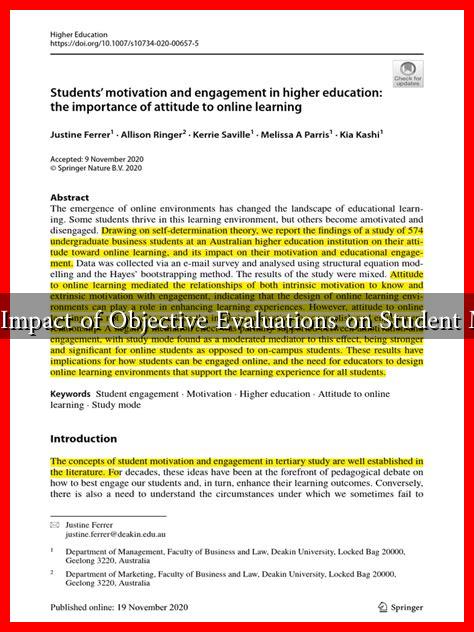-
Table of Contents
What’s the Impact of Objective Evaluations on Student Motivation?
In the realm of education, the methods used to evaluate student performance can significantly influence their motivation and engagement. Objective evaluations, which typically include standardized tests, quizzes, and other forms of assessment that yield quantifiable results, have become a focal point in discussions about educational effectiveness. This article explores the impact of these evaluations on student motivation, examining both the positive and negative aspects, supported by research and real-world examples.
Understanding Objective Evaluations
Objective evaluations are assessments designed to measure student performance in a standardized manner. They are characterized by their reliance on clear criteria and scoring rubrics, which aim to minimize subjectivity. Common forms of objective evaluations include:
- Standardized tests (e.g., SAT, ACT)
- Multiple-choice quizzes
- True/false assessments
- Fill-in-the-blank tests
These evaluations are often used to gauge student understanding, track progress, and inform instructional strategies. However, their impact on student motivation can vary widely.
The Positive Effects of Objective Evaluations
When implemented effectively, objective evaluations can enhance student motivation in several ways:
- Clear Expectations: Objective evaluations provide students with clear benchmarks for success. Knowing what is expected can motivate students to strive for those goals.
- Immediate Feedback: Many objective assessments offer quick results, allowing students to understand their strengths and weaknesses promptly. This feedback can encourage them to improve.
- Increased Accountability: Objective evaluations can foster a sense of responsibility among students, motivating them to take their studies seriously.
For instance, a study conducted by the National Center for Fair & Open Testing found that students who received regular feedback from objective assessments were more likely to engage in self-directed learning and set personal academic goals.
The Negative Effects of Objective Evaluations
Despite their potential benefits, objective evaluations can also have detrimental effects on student motivation:
- Test Anxiety: The pressure to perform well on standardized tests can lead to anxiety, which may hinder performance and motivation.
- Narrow Focus: Students may become overly focused on test scores rather than the learning process, leading to a superficial understanding of the material.
- Equity Issues: Objective evaluations may not account for diverse learning styles and backgrounds, potentially demotivating students who do not perform well in traditional testing environments.
A case study from the University of California, Berkeley, highlighted that students from underrepresented backgrounds often felt alienated by standardized testing, which negatively impacted their motivation and academic performance.
Balancing Objective Evaluations with Other Assessment Methods
To mitigate the negative impacts of objective evaluations, educators are increasingly adopting a balanced approach that includes various assessment methods. This can include:
- Formative assessments (e.g., quizzes, class discussions)
- Project-based assessments that allow for creativity and critical thinking
- Peer assessments that encourage collaboration and communication
Research from the American Educational Research Association suggests that a mixed-methods approach to assessment can enhance student motivation by providing multiple avenues for success and reducing the pressure associated with high-stakes testing.
Conclusion
The impact of objective evaluations on student motivation is multifaceted. While they can provide clear expectations and immediate feedback, they can also induce anxiety and promote a narrow focus on test scores. To foster a more motivating educational environment, it is essential for educators to balance objective evaluations with diverse assessment methods that cater to different learning styles and promote a deeper understanding of the material.
Ultimately, the goal should be to create a supportive learning atmosphere where students feel motivated to engage with the content, develop critical thinking skills, and achieve their academic potential. For further reading on this topic, you can explore resources from the American Educational Research Association.

